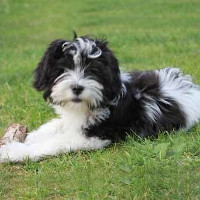Appearance of the Kyi-Leo
|
| Although these dogs are small in stature, they are generally well muscled with strong bones, making them quite sturdy for their stature, although they can be prone to leg or back injuries if they fall or attempt too ambitious a jump. They are longer than they are tall, with small, rounded skulls and straight, medium-length muzzles. Their prominent round black eyes are both gentle and alert, and their well-padded, mid-length ears hang like pendants from the sides of their heads. They have the same long, silky coat of their parent breeds, most often in white with black spots and markings, although some may have apricot, brown and even three-color markings instead, and their feathered tails fold over their backs. If not trimmed, the hair can hang over the face and mask the dog's eyes, but it rarely grows so long that it drags on the ground. |
Temperament of the Kyi-Leo
|
| Kyi-Leo dogs are generally very lively dogs, attached to their families and sociable with other animals, but because of their Lhasa Apso heritage, they can be a little wary of strangers. This can usually be remedied by ensuring that your small dog is highly socialized, preferably at an early age. They are generally very gentle and have been described as difficult to provoke, so by temperament they may be perfectly suited to respectful older children, but due to their small size and somewhat fragile backs and legs, any interactions with smaller or more chaotic children should be closely supervised. They are generally active and playful at home, sometimes to the point of clownishness, and although they are generally attention-seeking, they have no tendency towards separation anxiety. They tend to follow instructions well and show a great deal of patience, although a few individuals show a certain stubbornness during training, especially when it comes to home training. |
Needs and activities of the Kyi-Leo
|
| Although these tiny dogs are quite lively and energetic, they generally don't need much time to meet their exercise needs. While all dogs are happiest with a little time outdoors each day, indoor play can play an important role in a Kyi-Leo's daily activity, and they don't mind a reasonable amount of time alone. They make excellent companions in smaller spaces such as houses or apartments and, because of their acute hearing and alert nature, they also make admirable watchdogs. With traditional walks and lively games of fetch indoors, this breed would be well suited to competitive obedience and agility training. |
Maintenance of the Kyi-Leo
|
| Like the two parent breeds, the Kyi-Leo has a long coat of silky hair rather than fur, making it a good choice for most allergy sufferers, but the coat requires a lot of grooming to keep it clean and tangle-free. The Kyi-Leo's coat is particularly prone to tangles and usually requires a long brushing session every day to avoid staining. Many Kyi-Leo owners learn to trim their dog's coat or choose to take their dog to the groomer regularly, usually every six to eight weeks. Although trimmed Kyi-Leo dogs still require daily grooming, it's a much simpler affair than when their coats are longer. As with all small dogs, teeth should be brushed several times a week. |







 English (United Kingdom)
English (United Kingdom)